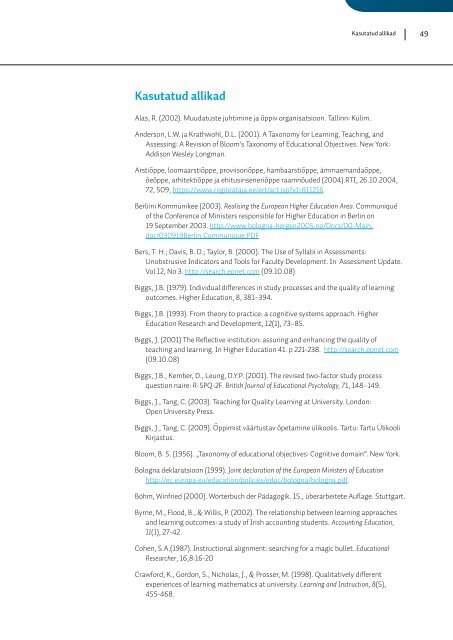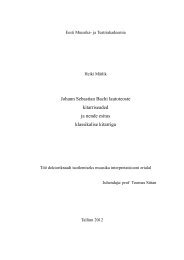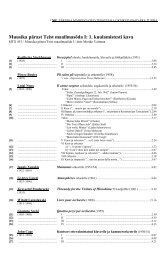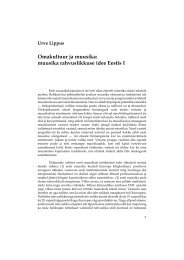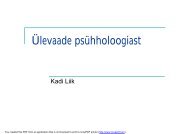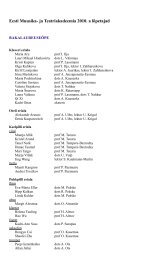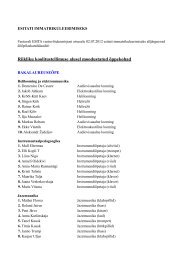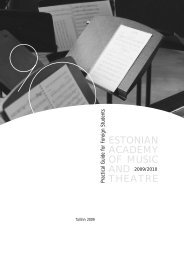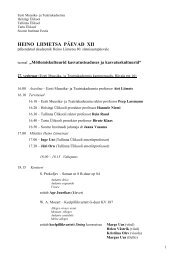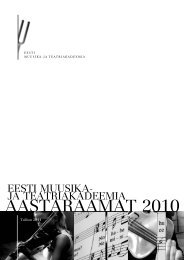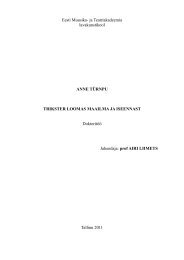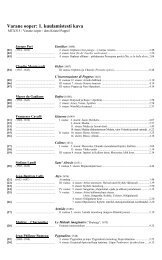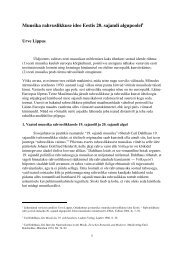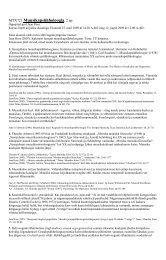Õppekava arendamise juhendmaterjal (.pdf)
Õppekava arendamise juhendmaterjal (.pdf)
Õppekava arendamise juhendmaterjal (.pdf)
Create successful ePaper yourself
Turn your PDF publications into a flip-book with our unique Google optimized e-Paper software.
Kasutatud allikad49Kasutatud allikadAlas, R. (2002). Muudatuste juhtimine ja õppiv organisatsioon. Tallinn: Külim.Anderson, L.W. ja Krathwohl, D.L. (2001). A Taxonomy for Learning, Teaching, andAssessing: A Revision of Bloom’s Taxonomy of Educational Objectives. New York:Addison Wesley Longman.Arstiõppe, loomaarstiõppe, proviisoriõppe, hambaarstiõppe, ämmaemandaõppe,õeõppe, arhitektiõppe ja ehitusinseneriõppe raamnõuded (2004).RTI, 26.10.2004,72, 509, https://www.riigiteataja.ee/ert/act.jsp?id=811216Berliini Kommünikee (2003). Realising the European Higher Education Area. Communiquéof the Conference of Ministers responsible for Higher Education in Berlin on19 September 2003. http://www.bologna-bergen2005.no/Docs/00-Main_doc/030919Berlin_Communique.PDFBers, T. H.; Davis, B. D.; Taylor, B. (2000). The Use of Syllabi in Assessments:Unobstrusive Indicators and Tools for Faculty Development. In Assessment Update.Vol 12, No 3. http://search.epnet.com (09.10.08)Biggs, J.B. (1979). Individual differences in study processes and the quality of learningoutcomes. Higher Education, 8, 381–394.Biggs, J.B. (1993). From theory to practice: a cognitive systems approach. HigherEducation Research and Development, 12(1), 73–85.Biggs, J. (2001) The Reflective institution: assuring and enhancing the quality ofteaching and learning. In Higher Education 41. p 221-238. http://search.epnet.com(09.10.08)Biggs, J.B., Kember, D., Leung, D.Y.P. (2001). The revised two-factor study processquestion naire: R-SPQ-2F. British Journal of Educational Psychology, 71, 148–149.Biggs, J., Tang, C. (2003). Teaching for Quality Learning at University. London:Open University Press.Biggs, J., Tang, C. (2009). Õppimist väärtustav õpetamine ülikoolis. Tartu: Tartu ÜlikooliKirjastus.Bloom, B. S. (1956). „Taxonomy of educational objectives: Cognitive domain“. New York.Bologna deklaratsioon (1999). Joint declaration of the European Ministers of Educationhttp://ec.europa.eu/education/policies/educ/bologna/bologna.<strong>pdf</strong>.Böhm, Winfried (2000). Wörterbuch der Pädagogik. 15., überarbeitete Auflage. Stuttgart.Byrne, M., Flood, B., & Willis, P. (2002). The relationship between learning approachesand learning outcomes: a study of Irish accounting students. Accounting Education,11(1), 27-42.Cohen, S.A.(1987). Instructional alignment: searching for a magic bullet. EducationalResearcher, 16,8:16-20Crawford, K., Gordon, S., Nicholas, J., & Prosser, M. (1998). Qualitatively differentexperiences of learning mathematics at university. Learning and Instruction, 8(5),455-468.


